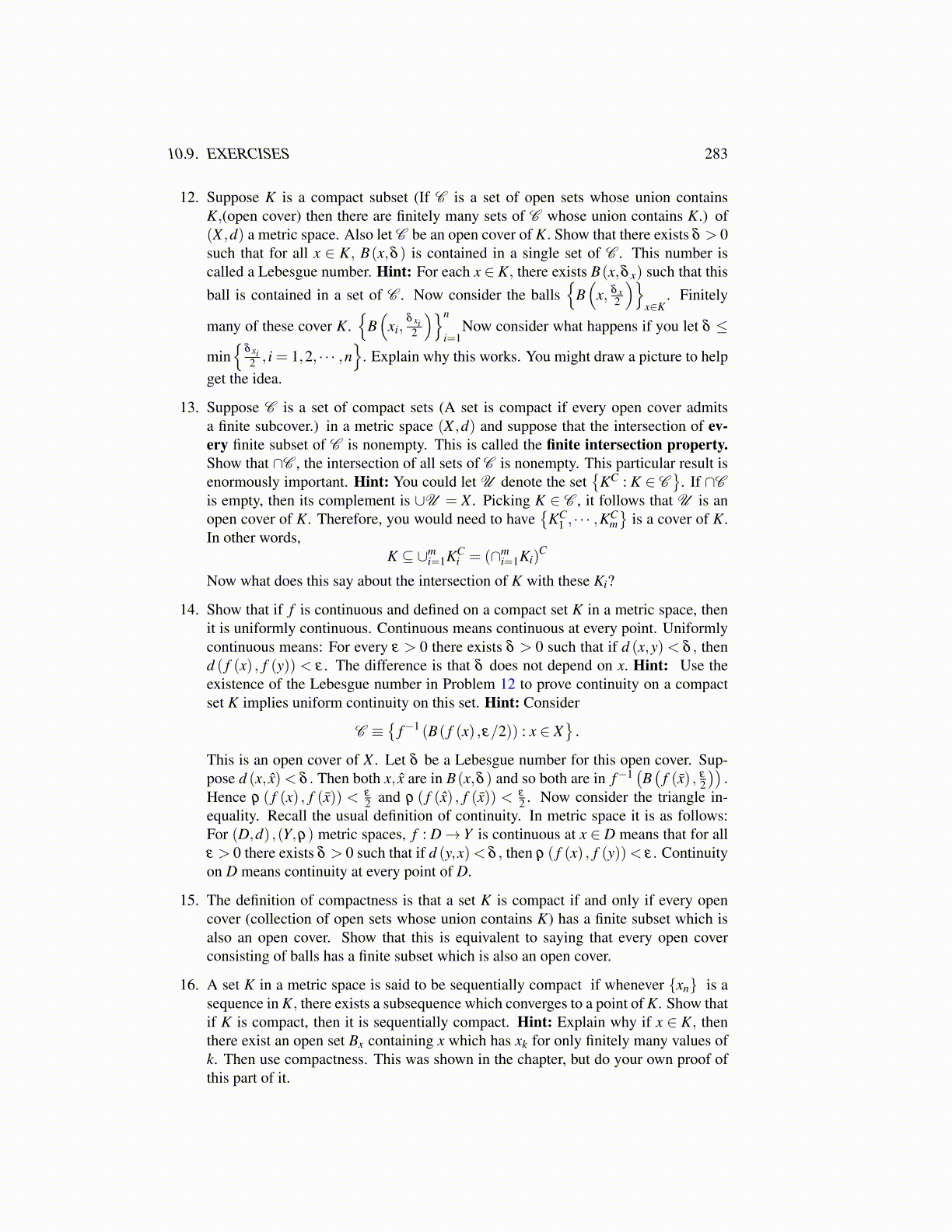
10.9. EXERCISES 283
12. Suppose K is a compact subset (If C is a set of open sets whose union containsK,(open cover) then there are finitely many sets of C whose union contains K.) of(X ,d) a metric space. Also let C be an open cover of K. Show that there exists δ > 0such that for all x ∈ K, B(x,δ ) is contained in a single set of C . This number iscalled a Lebesgue number. Hint: For each x ∈ K, there exists B(x,δ x) such that thisball is contained in a set of C . Now consider the balls
{B(
x, δ x2
)}x∈K
. Finitely
many of these cover K.{
B(
xi,δ xi2
)}n
i=1Now consider what happens if you let δ ≤
min{
δ xi2 , i = 1,2, · · · ,n
}. Explain why this works. You might draw a picture to help
get the idea.
13. Suppose C is a set of compact sets (A set is compact if every open cover admitsa finite subcover.) in a metric space (X ,d) and suppose that the intersection of ev-ery finite subset of C is nonempty. This is called the finite intersection property.Show that ∩C , the intersection of all sets of C is nonempty. This particular result isenormously important. Hint: You could let U denote the set
{KC : K ∈ C
}. If ∩C
is empty, then its complement is ∪U = X . Picking K ∈ C , it follows that U is anopen cover of K. Therefore, you would need to have
{KC
1 , · · · ,KCm}
is a cover of K.In other words,
K ⊆ ∪mi=1KC
i = (∩mi=1Ki)
C
Now what does this say about the intersection of K with these Ki?
14. Show that if f is continuous and defined on a compact set K in a metric space, thenit is uniformly continuous. Continuous means continuous at every point. Uniformlycontinuous means: For every ε > 0 there exists δ > 0 such that if d (x,y) < δ , thend ( f (x) , f (y)) < ε . The difference is that δ does not depend on x. Hint: Use theexistence of the Lebesgue number in Problem 12 to prove continuity on a compactset K implies uniform continuity on this set. Hint: Consider
C ≡{
f−1 (B( f (x) ,ε/2)) : x ∈ X}.
This is an open cover of X . Let δ be a Lebesgue number for this open cover. Sup-pose d (x, x̂)< δ . Then both x, x̂ are in B(x,δ ) and so both are in f−1
(B(
f (x̄) , ε
2
)).
Hence ρ ( f (x) , f (x̄)) < ε
2 and ρ ( f (x̂) , f (x̄)) < ε
2 . Now consider the triangle in-equality. Recall the usual definition of continuity. In metric space it is as follows:For (D,d) ,(Y,ρ) metric spaces, f : D→ Y is continuous at x ∈ D means that for allε > 0 there exists δ > 0 such that if d (y,x)< δ , then ρ ( f (x) , f (y))< ε . Continuityon D means continuity at every point of D.
15. The definition of compactness is that a set K is compact if and only if every opencover (collection of open sets whose union contains K) has a finite subset which isalso an open cover. Show that this is equivalent to saying that every open coverconsisting of balls has a finite subset which is also an open cover.
16. A set K in a metric space is said to be sequentially compact if whenever {xn} is asequence in K, there exists a subsequence which converges to a point of K. Show thatif K is compact, then it is sequentially compact. Hint: Explain why if x ∈ K, thenthere exist an open set Bx containing x which has xk for only finitely many values ofk. Then use compactness. This was shown in the chapter, but do your own proof ofthis part of it.